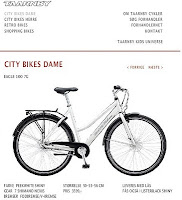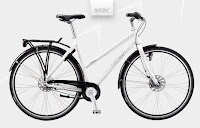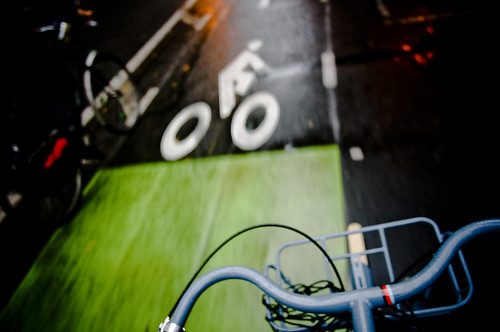

I hadn’t really thought about the concept of greenwashing… bicycles… before. Wifealiciousness showed me a Danish bicycle in a fashion magazine - Eurowoman. One I had never heard of before. The text - short and sweet like most captions in fashion magazines [to be read inbetween sips of café lattes] - read, “A bicycle doesn’t pollute and while you pedal you get fit. Danish Eco2bikes bicycles are made of aluminium, which is easy to recycle and the bicycles feature an environmentally-friendly lacquer.”
Hmm, thought I. Since when did aluminium become a USP for bicycles?! And is an 'environmentally-friendly' lacquer really that vital in the race to save polar bears?
So I googled this brand and found the Eco2bikes website, looking forward to a warm and fuzzy 'Yeah! We're saving the fucking planet!' sensation of idealism.
Um... well... looking through the website I couldn't find any Golden Ratio for their design concept. I couldn't see glaciers re-freezing and un-calving. I just saw a white bicycle. Looks like most of the other bicycles since Bicycle Culture 1.0 - 130 years ago or so.All I could vacuum up off their website was this:We are streets ahead of our competitors when it comes to ensuring that our bicycles are eco-friendly and made of recyclable materials. The result is an uncompromising product.
There are no details about how their bicycle are more eco-friendly than others nor any details about the recyclable materials. Maybe they are referring to the aluminium frame which is "easier" to recycle? Couldn't find info about the magical lacquer manufactured from sustainable plants grown on happy and productive eco-communes in Nicaragua, either.Hang on... just found it. Buried on the page featuring their co2 calculator. How innovative.
"The frame of your new bicycle is made of aluminium, which is easy to melt down when it reaches the end of its useful life in many years' time. The bicycle is lacquered with water-based lacquer from a supplier certified according to ISO 9001:2000 and ISO 14001:2004. In brief: No compromises."That's it. That's their environmentally-friendly, world-changing offer to you, the consumer.
By choosing the Eco2, you can be sure of getting the market's most environmentally friendly product in its manufacture and choice of materials. With an aluminium frame and energy-saving external gears, you will move with a lightness you have never experienced before.
So... external gears are now energy-saving? The vast majority of the Danish/Dutch population who ride with internal gears are eco-sinners/Bushites/Exxon shareholders, or what?At this point I was already sniffing 'lame' and this is when 'greenwashing' started to trickle into my mind. I could find no reference to any ecologically-friendly design guidelines, like the OKALA from the Industrial Designers Society of America or anything near it.
If you're looking for the cheapest bike on the market, this is not the place for you. The Eco2 combines functionality, comfort and design in a unit that matches both the hectic city beat and more tranquil surroundings. Your first encounter with the Eco2 is the design - created by bike lovers. When you take hold of the handlebars for the first time, you will feel an ergonomic shaping you have never felt before. And that's how it is in every detail.
Let's be honest. Every bicycle combines functionality, comfort and design that matches the hectic city beat and more tranquil surroundings. The design? The ergonomic shaping? All I can see are green-coloured gear cables running from the handlebars into the frame and on to those planet-saving external gears.Here's the funny bit. The price. In the Eurowoman article it's listed at 7995 kroner.
That's $1600. €1050. Seriously.If you're going to sell a bicycle for that price, at the very least do something spectacular with the design. You're Danish, for god's sake. This is DesignLand. Hell, just something new and interesting. Like Ri'saikl, Biomega, Retrovelo, Larry vs Harry. If white bicycles are your nasty thang, then how about Strömmen?
As it is now, the Eco2 bikes just look like every other white city bike on the market in Denmark, among them: Except for the green gear cables, of course. Above you have a:- Taarnby white city bike with a RRP of 4199 kroner [$840/€560]- Raleigh white city bike with a RRP of 5299 kroner [$1050/€700]- MBK white city bike with a RRP of 4299 kroner [$869/€570]Just when we have enough work to do countering the profiteers who continue to attempt to overcomplicate cycling we now have to deal with people selling bicycles like this.I travel around the world speaking about how ramming 'health' and 'environment' down peoples throats doesn't get them onto bikes - infrastructure and taming the automobile does. Then I get home to find this.Bicycles are, by nature, environmentally-friendly. Even the ones without the external gears and green gear cables. If you want a white bicycle, one that is medicine for the urban landscape, choose another brand and save thousands of kroner.
In the midst of writing this post I remembered that I was once offered an 'eco-friendly' bicycle. It was in Portland, last October. Jay Graves from BikeGallery offered me a bike on which to ride around the city and it was a American brand. A Trek. I recall them telling me that it was 'eco-friendly' but that was in one ear and out the other. All I remember was that it was a cool ride and a nice blue colour.
So, checking out the bicycle behemoth's website I found the page about the bike I borrowed, the Belleville.
First thing I noticed was a reference to the above-mentioned OKALA guidelines. Not to mention a more detailed description of why Trek thinks their bikes are eco-delicious. They've gone to the trouble to tell me about it. As a consumer, I appreciate detail and despise used car salesman techniques.Greenwashing the bicycle, indeed.








